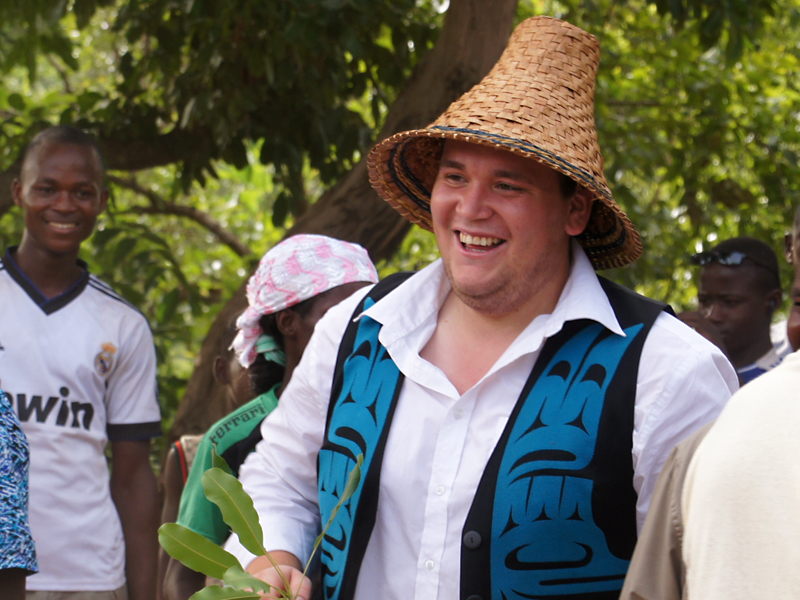Tla-o-qui-at student shares knowledge in Ghana
- Anne MacLaurin

Visual Arts and Indigenous Studies (minor) student Hjalmer Wenstob went to Ghana this summer as a First Nations research apprentice under the mentorship of geography professor Dr. Phil Dearden. Wenstob, a member of the Tla-o-qui-aht Nation, whose traditional territory is around Tofino, was interested in learning about eco-tourism and community-based conservation practices in other parts of the world.
His experiences and course work were supported by the Le,Nonet project, which offers Aboriginal students culturally relevant supportive programs, community experiences, peer mentoring and financial assistance.
While in Ghana, Wenstob shared his own traditional practice and knowledge. “I was there representing UVic but also my nation, the Tla-o-qui-aht,” he says.
Wenstob is involved with Tribal Parks and Protected Areas and Poverty Reduction programs in his home territory, and he learns and practices traditional knowledge in regards to the land and wildlife.
“Ghana and the Tla-o-qui-aht have similar challenges using traditional knowledge in community-based conservation practices,” Wenstob explains.
The research trip to Ghana presented the perfect opportunity for him to talk with numerous communities about conservation, traditional knowledge and eco-tourism. There, people are eager to develop eco-tourism business, but there are concerns and challenges with wildlife encroachment on villages and wildlife poaching. In particular, there has been a great depletion in the number of elephants due to poaching.
For 12 days Wenstob and the group traveled throughout Ghana, experiencing the richness of culture in the face of economic poverty. The cultural performances, dances and songs connected the Ghanaians to the Canadian visitors. The Ghanaians do not see themselves as poor and are quick to point out their rich village life, says Wenstob.
“There is such a thing as cultural poverty,” he explains. “We have cars, TVs, expensive clothes, but how do we celebrate our traditions, our culture?”
A particularly memorable moment for Wenstob occurred when he performed a traditional Coast Salish thank-you song for the Ghanaians, who immediately joined in the singing and dancing. The cultural performance established common ground and trust between the groups, he explains.
The research done in Ghana will be compiled into a report at the end of the year for the research partnership (PAPR, Protected Areas and Poverty Reduction—A Canada-Africa Learning Alliance). The villages will receive a series of recommendations and suggestions on community-based conservation practices.
Next year, groups from Ghana and Tanzania will visit Canada’s West Coast and gather in the traditional territory of the Tla-o-qui-aht Nation.
“Our people are already collecting and gathering the berries and special plants in preparation for sharing our traditional foods with our visitors when they come to our lands,” says Wenstob.
Wenstob is also a carver and last May he won a scholarship from the Vancouver Art Foundation to create a work of art to be displayed in the Vancouver airport for one year. He carved the pole alongside his grandfather/mentor and it is now on display at the airport. The pole is named TLEHPIKA, and it represents the story of his great ancestor and where his family name originated.

